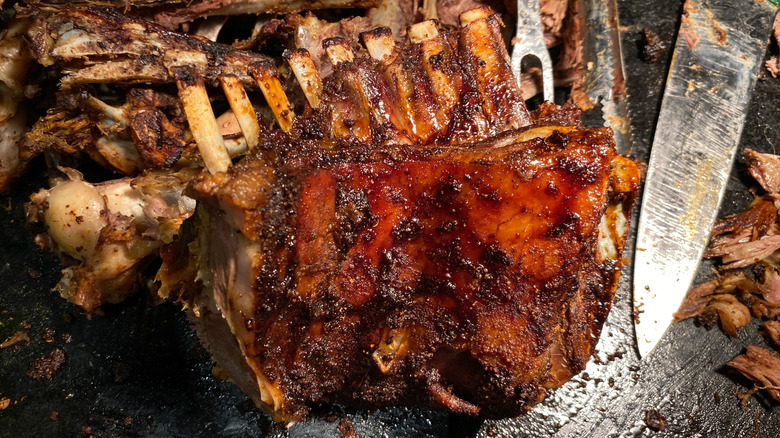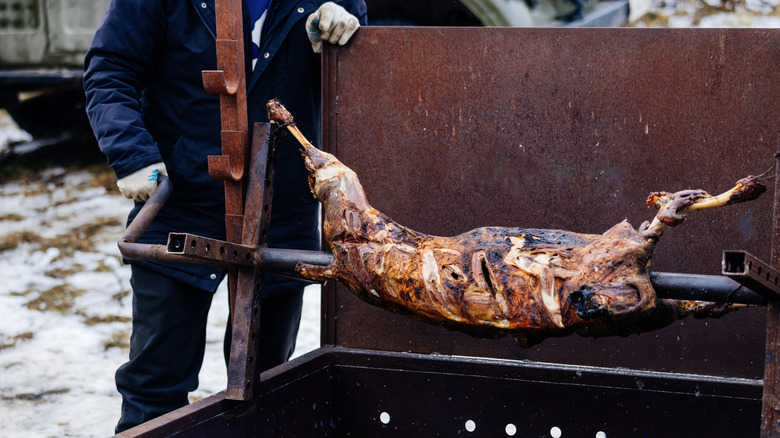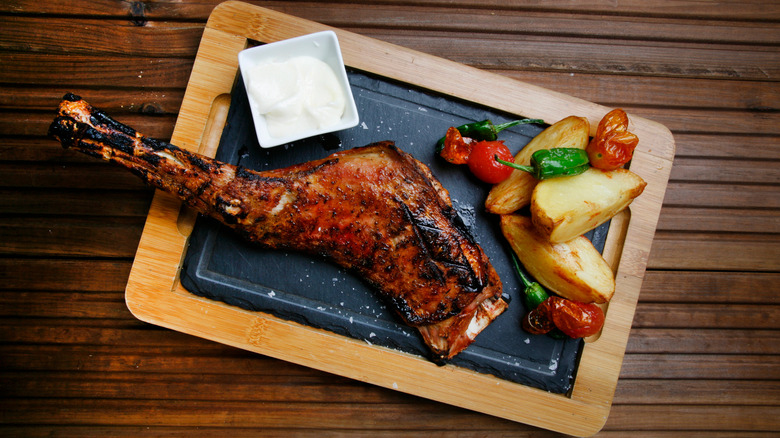Why You Won't Find This Old-School Type Of Ribs At BBQs Anymore
When you think of barbecue ribs, they tend to be sauced or dry-rubbed pork and beef. Cooked slow, smoked, and with dry heat, barbecuing has a very different outcome than just grilling. Texas, St. Louis, and the Carolinas all have their own barbecue style, but these places didn't always use cows or pigs for this dish. In truth, early American barbecue tended to feature goat or sheep instead.
While this may sound strange to you considering the gamey flavor goat or lamb can have, these meats have a longer barbecue history than beef or pork. Barbecue was first brought to the United States by Mexican influence, and then was strengthened by the availability of goat and sheep meat in the early 1800s. Even in more modern history, one of the first yearly barbecue competitions — founded in 1973 — was a barbecued goat cook-off. It's still held today, and sometimes features ribs. Barbecue was initially a way to soften and make tough, strong-tasting meats more palatable. Goat and mutton can be very chewy, which made them perfect candidates.
However, over time, this vintage dish has mostly vanished. Barbecue preferences nowadays skew more toward fatty meats, which means that beef and pork are more desirable. Barbecue goat and mutton tend to be leaner and less juicy, so they simply aren't as popular. This shift in consumer preferences, along with an increase in the availability of beef during the late 1800s, is why you rarely see barbecue sheep or goat ribs on menus anymore.
Why goat and lamb used to reign supreme
There are two main reasons why lamb and goat used to get the edge over beef, and they have to do with barbecue's origins. By most accounts, we get the word barbecue from the Mexican word "barbacoa." In turn, Barbacoa has ancient origins from the Taíno word "barabicu," which was used on islands such as Jamaica and Cuba during the 1500s. In these cultures, two meats they had regular access to and commonly used were goat and sheep. While adult sheep or goats were plentiful, they tended to have tough meat, so lamb or young goats were often alternatives. Over time, this style of slow-cooking smoked meats made its way up into the United States. It didn't take long for the U.S. to make its own version, gradually morphing into what we think of as barbecue today.
Even in the United States, sheep were often the go-to during the initial days of our barbecuing. People tend to use whatever meat or goods they have a surplus of, and in 1816, the U.S. wool industry experienced a massive boom. This meant there were tons of sheep that were too old and tough to be eaten with basic cooking methods. Instead, mutton barbecue became a regular offering, with cooks slowly barbecuing whole sheep for many hours. It wasn't until the beef industry started to take off throughout the United States in the later 1800s that beef barbecue became more popular. By the time WWII ended, Americans were firmly smitten with beef over mutton and goat.
You can still find these meats on certain menus
Even though you're unlikely to find these old-school meats making people drool at your next cookout, that doesn't mean they've completely disappeared. In the United States, you can still find American-style barbecue lamb and goat in some states if you know where to look. A few traditional restaurants in southern areas, such as Texas, still carry on with recipes similar to the first ones that came to the states, and goat is still a prevalent meat in Alaska. In western Kentucky, mutton barbecue continues to be incredibly popular. You might even be lucky enough to find some barbecue ribs.
However, if you're craving these tangy meats cooked up by barbecue outside of these specific areas, you may have to turn to international restaurants. Other countries, such as India and Indonesia, sometimes use goat and lamb over beef and have their own traditional barbecue-style cooking methods. For example, ask about barbecue tandoori dishes in Indian restaurants that have goat or lamb. You can also look for barbecue goat or lamb in African, Middle Eastern, and Caribbean restaurants, where it's culturally popular. Lastly, you can always check out traditional Mexican or Jamaican restaurants; there, you're likely to find the forefather dishes that eventually became American lamb and goat barbecue.


